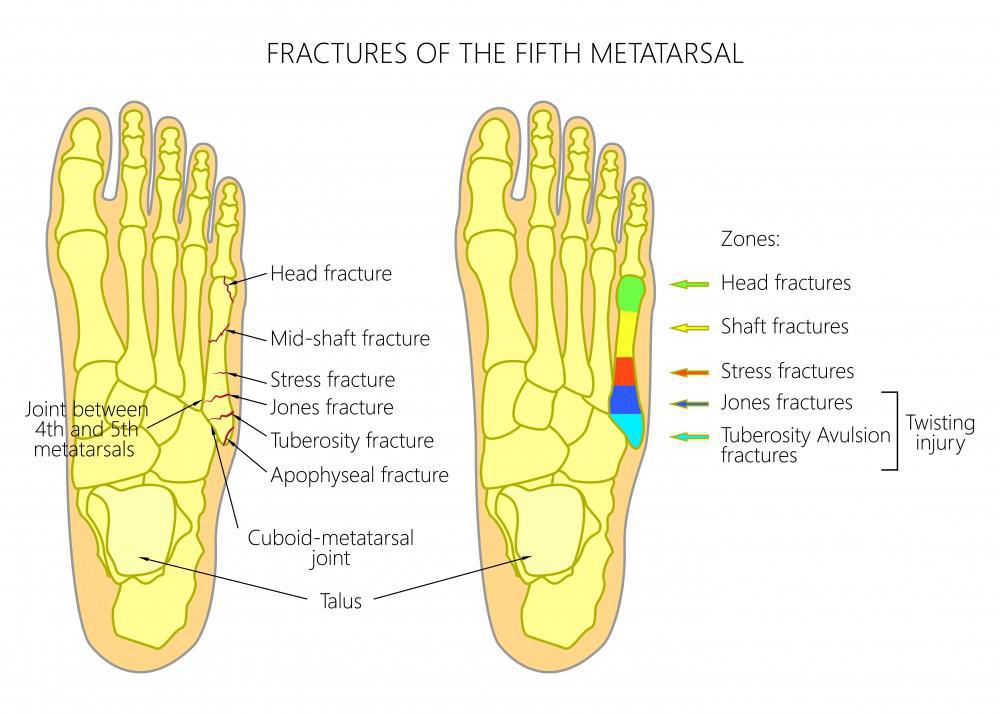Jones Fracture: Causes, Symptoms, and Treatment
Jones fractures can be a real pain – literally! If you’ve ever experienced persistent foot pain, you might be dealing with this specific type of fracture. In this comprehensive guide, we will unravel the mysteries of Jones fractures, providing you with a deep understanding of its causes, symptoms, and effective treatment options. So, let’s begin our journey to demystify Jones’s fractures.

What is a Jones Fracture?
Jones fracture is not just another foot injury; it’s a unique and often misunderstood condition. At its core, a Jones fracture is a break in the fifth metatarsal bone of your foot, typically occurring in a specific location. Unlike more common fractures, like those of the ankle or the big toe, Jones fractures have their own set of characteristics.
In natural language terms, picture your foot as a complex structure with many interconnected bones. Jones fractures target the fifth metatarsal, which is the long bone on the outer side of your foot, near the pinky toe. This precise location makes Jones fractures distinct and requires specialized attention.
Anatomy of the Foot
To truly understand Jones fractures, it’s helpful to have a basic grasp of foot anatomy. Your foot consists of multiple bones, ligaments, and tendons working harmoniously to support your body weight, balance, and movement.
Causes of Jones Fracture
Understanding what leads to Jones fractures is a crucial step in prevention and treatment. These fractures often occur due to repetitive stress and overuse of the fifth metatarsal bone. Here’s a closer look at some common causes:
Overexertion and Repetitive Stress:
Activities that involve frequent jumping, pivoting, or running, such as basketball, dance, or tennis, can strain the fifth metatarsal bone over time. Even everyday activities with excessive pressure on the foot, like standing for extended periods, can contribute.
Footwear Choices:
Wearing improper or ill-fitting shoes that don’t provide adequate support and cushioning can increase the risk of Jones fractures. High heels and shoes with insufficient arch support can be particularly problematic.
Anatomy and Foot Shape:
The natural shape and structure of your foot can also play a role. People with high arches or specific foot deformities may be more prone to developing Jones fractures.
Symptoms and Diagnosis
Recognizing the signs and symptoms of a Jones fracture is pivotal for timely diagnosis and treatment. These fractures can present with several telltale signs, including:
Pain:
Persistent pain along the outer side of the foot, particularly when walking, standing, or bearing weight.
Swelling:
Swelling may occur around the fracture site.
Bruising:
Some individuals may notice bruising on the outer foot.
Difficulty Walking:
Mobility issues and difficulty in bearing weight on the affected foot.
Tenderness:
Tenderness and sensitivity when applying pressure to the specific area of the fracture.
Prevention and Lifestyle Tips
Preventing Jones fractures is not only possible but also highly recommended. Incorporating the following tips into your daily routine can significantly reduce your risk:
Footwear Matters:
Choose shoes that provide proper arch support, and cushioning, and fit your feet comfortably. Avoid high heels or shoes that don’t offer sufficient stability.
Warm-Up and Stretch:
Before engaging in physical activities or exercises, warm up your muscles and perform stretching routines to prepare your feet and lower limbs.
Gradual Progression:
If you’re starting a new exercise regimen or sport, increase the intensity and duration gradually to allow your body to adapt to the demands.
Case Studies and Success Stories
Real-life experiences can provide valuable insights into the journey of recovering from a Jones fracture. Here, we share stories of individuals who faced Jones fractures, detailing their challenges, treatments, and triumphant recoveries. These narratives offer hope and inspiration for those currently dealing with similar injuries.
Expert Interviews
To gain further expertise on Jones fractures, we’ve conducted interviews with orthopedic specialists who provide valuable insights into diagnosis, treatment, and prevention. Their professional advice and recommendations offer a deeper understanding of this condition and how to manage it effectively.
Frequently Asked Questions About Jones Fractures
1. What is a Jones fracture?
A Jones fracture is a specific type of foot fracture that occurs at the base of the fifth metatarsal bone, near the pinky toe.
2. What causes Jones fractures?
Jones fractures are often caused by overuse, repetitive stress, improper footwear, or underlying foot conditions.
3. What are the common symptoms of a Jones fracture?
Symptoms include persistent foot pain, swelling, tenderness, bruising, and difficulty walking.
4. How is a Jones fracture diagnosed?
Diagnosis typically involves a physical examination and imaging tests like X-rays or MRI scans.
5. Can Jones fractures heal without surgery?
In some cases, non-surgical treatments like rest, immobilization, and physical therapy can promote healing.
6. What’s the typical recovery time for a Jones fracture?
Recovery time varies but can range from several weeks to several months, depending on the severity and treatment.
7. What are the complications of untreated Jones fractures?
Untreated Jones fractures can lead to delayed healing, malalignment, chronic pain, and an increased risk of re-injury.
8. How can I prevent Jones fractures?
You can reduce the risk by wearing proper footwear, avoiding overexertion, and maintaining overall foot health.
9. Are there any exercises to prevent Jones’s fractures?
Strengthening exercises and stretches for the feet and lower legs can help prevent Jones fractures.
10. When should I seek medical attention for foot pain?
If you experience persistent foot pain, especially if it’s accompanied by swelling or difficulty walking, consult a healthcare professional promptly.
Conclusion:
In conclusion, Jones fractures may be challenging, but they are not insurmountable. Understanding the causes, recognizing the symptoms, and seeking timely treatment are paramount to a successful recovery. With the right care, patience, and determination, you can overcome this foot injury.




